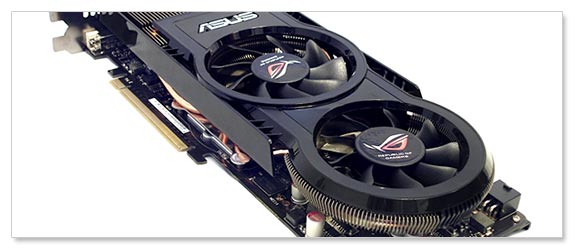Custom Cooled Video Card Shootout: ASUS & MSI
ASUS ROG ENGTX260 Matrix
The ASUS Matrix series of video cards will be familiar to regular HotHardware readers. We have reviewed several members if the Matrix line-up in the past year such as the EAH4850, EAH4870 and EN9800GT. Like most previously reviewed ASUS Matrix cards, the ENGTX260 doesn't offer a factory overclock, however it does have quite a few goodies to help you overclock on your own.
At first glance, the ENGTX260 appears to be using the same cooling setup as the previously reviewed ASUS ROG EAH4870 Matrix. Closer inspection reveals the two cooling systems aren't exactly identical. Most noticeably, the ENGTX260 has a longer PCB and as a result the cooler is also longer than that found on the EAH4870. The cooler is separated into four pieces, covered by a black plastic shroud. Each piece is a substantial heatsink and each heatsink is connected to the base plate which makes direct contact with the GPU via a dedicated copper heatpipe. This is the same arrangement found on the EAH4870. However, the heatsink section closest to the I/O outputs is nearly three times as large as the one found on the EAH4870 thanks to the card's extended length. This means the ENGTX260's cooling system had quite a bit more surface area which usually translates into better cooling performance.
In terms of features, the ENGTX260 is identical to the EAH4870. The PCB is endowed with a dedicated controller chip ASUS calls the "Super Hybrid Engine" which handles a number of duties like monitoring and regulating how the card behaves, as well as controlling adjustments to the card and cooling system's function. The Super Hybrid Engine is controlled using the iTracker utility program from which the user can set up performance profiles, adjust any number of performance parameters including overclocking options for the core clock, shader and memory.
The performance profiles also include settings for the cooling system, which are quite advanced. Not only can you set up the usual controls like fan speed and temperature triggers, but the cooling systems also has several automated features which can be enabled. Most notably, the iTracker utility can distinguish whether the card is currently operating in 2D or 3D mode and different profiles can be setup for each circumstance.
This makes it possible to set up a low-noise, low-power cooling and performance profile that turns down the fans and even downclocks the GPU while in 2D mode, such as during casual web surfing. Then for 3D applications, a more performance oriented profile can be used. The two fans can also be controlled individually and 1-fan operation is possible. The cooling system can also operate passively in 2D mode, although this feature resulted in very high GPU temperatures. Overall, the controls available are fairly robust and certainly far beyond anything that can be done using NVIDIA's stock tweaking utilities.
In many ways it is a GeForce GTX 260 version of the EAH4870 we reviewed previously. Unfortunately this means it also has the same flaws, the most annoying of which is probably the poor default performance profile. Out-of-the-box and without and tweaking, the ROG ENGTX260 Matrix has a fairly aggressive performance profile that ramps the fans up more than we believe is necessary, making it noticeably louder than a stock reference cooler. However, this can be easily remedied with a few quick tweaks in iTracker. We were able to set up a profile very quickly that allowed for very quiet operation without overheating the card.
The ROG ENGTX260 Matrix comes with a fairly typical bundle. Included in the box is a DVI to D-sub adapter, DVI to HDMI adapter, HDTV-out cable, molex to PCI-E power cable and S/PDIF cable. This pretty much covers all the bases and should be enough to get you started.
Update: The ENGTX260 Matrix can now use the second generation iTracker utility; iTracker2.











